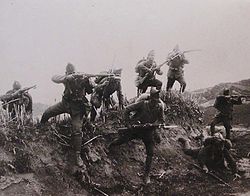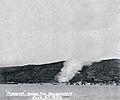| Greek Summer Offensive 1920 | |||||||
|---|---|---|---|---|---|---|---|
| Part of the Greco-Turkish War (1919–22) | |||||||
 Greek soldiers advancing. | |||||||
| |||||||
| Belligerents | |||||||
|
| |||||||
| Commanders and leaders | |||||||
| Strength | |||||||
|
| |||||||
| Casualties and losses | |||||||
| Unknown | Unknown | ||||||
The Greek Summer Offensive of 1920 was an offensive by the Greek army, assisted by British forces, to capture the southern region of the Sea of Marmara and the Aegean Region from the Kuva-yi Milliye (National Forces) of the provisional Turkish national movement government in Ankara. Additionally, the Greek and British forces were supported by the Kuva-yi Inzibatiye (Forces of Order) of the Ottoman government in Constantinople, which sought to crush the Turkish nationalist forces. The offensive was part of the Greco-Turkish War and was one of several engagements where British troops assisted the advancing Greek army. British troops actively took part in invading coastal towns of the Sea of Marmara. With the approval of the Allies, the Greeks started their offensive on 22 June 1920 and crossed the 'Milne Line'. [6] [7] The 'Milne Line' was the demarcation line between Greece and Turkey, laid down in Paris. [8] Resistance by the Turkish nationalists was limited, as they had few and ill-equipped troops in western Anatolia. [8] They were also busy on the eastern and southern fronts. [6] [8] After offering some opposition, they retreated to Eskişehir on Mustafa Kemal Pasha's order. [8]
Prelude
In May 1920, the Kuva-yi Inzibatiye, backed by the British, had been sent to seize the area of Geyve and İzmit, but they were repelled by the Turkish irregular forces. Subsequently, British aeroplanes bombed the Turkish positions in İzmit with little outcome. [9] 3 regiments from the Kuva-yi Inzibatiye entrenched themselves at the outskirts of İzmit. Behind them were 2-3 British battalions and furthermore they were backed up by several British battleships from the sea. [9] On 15 June, the Turkish nationalists tried to advance towards the Ottoman and British positions, but they made little progress, as British battleships and planes started to bomb them on 16–17 June. [9] On this occasion, the British 15-inch naval guns saw their first action by bombing Turkish positions. [10] [11]

Offensive
Since they couldn't depend on the Kuva-yi Inzibatiye as the situation was a stalemate, the fighting around İzmit was key to the British deciding to bring in the Greek army for assistance and to punish the attacks on their troops. [9] [12] The Greeks, meanwhile, were eager to conquer their historical homeland. The British military staff together with the Greek military staff planned the offensive for the southern coastal area of the Sea of Marmara and the Aegean Region. [9] With these plans the Greek army started its offensive on 22 June 1920.
During the offensive, British and Greek troops jointly captured the following towns, some of these towns were invaded by naval landing forces: [13] [14] Akhisar (22 June); Kırkağaç, Soma and Salihli (24 June); Alaşehir (25 June); Kula (28 June); Balıkesir (30 June); Bandırma, Kirmasti and Karacabey (2 July); Nazilli (3 July); Gemlik and Mudanya (6 July); Bursa (8 July); Karamürsel (11 July); İznik (12 July); Gediz and Ulubey (28 August); Uşak (29 August); Simav (3 September). During the offensive against these areas, several clashes occurred between the advancing British-Greek troops and the defending Turkish irregular forces. For example, Mudanya had been tried to be captured as early as 25 June by naval landing forces, but stubborn Turkish resistance inflicted casualties on British forces and forced them to withdraw. On 6 July a British fleet of 12 ships bombed the town for three hours which killed 25 Turkish soldiers during the bombardment. After the bombardment British troops landed and took control of the town. There were many instances of successful delaying operations of small Turkish irregular forces against numerical superior enemy troops. Such as in Savaştepe when a Turkish irregular unit of 200 men delayed a Greek division of 10,000 men for one day. [15]
By reaching Uşak on 29 June, the Greek army had advanced some 201 km (125 mi). [16] Apart from these major settlements, several other smaller settlements were captured during the offensive.
Aftermath
The Turkish nationalists started a small counter-attack in the area of Gediz, but it wasn't successful.
Gallery
-
Greek troops in Mudanya.
-
British landing at Mudanya, 25 June 1920.
-
A captured nationalist Turkish soldier on board HMS Royal Sovereign during the assault on Mudanya, 6 July 1920.
-
HMS Royal Sovereign's 6-inch guns in action bombarding Mudanya, 6 July 1920.
-
Burning caused by the bombardment, 6 July 1920, Mudanya.
-
The return of HMS Royal Sovereign's seaman after forced landing under heavy machine gun & rifle fire. (Mudanya, July 1920)
-
Royal Marines landing at Mudanya.
-
Greek and American troops landing at Bandirma (Panormos).
-
General Paraskevopoulos with King Alexander in Panormos.
-
Turkish prisoners captured at Izmit by the British forces. The three men standing together at the front were accused to be the ringleaders and they were subsequently executed in June 1920.
-
Execution of a Kemalist Turk, by the British forces in Izmit.
-
Turkish man who was accused of spying for the Turkish army is executed by Greek troops.
-
British officer inspecting Greek troops and trenches.
See also
References
- ^ Erdem, Nilüfer (2010). Yunan tarihçiliğinin gözüyle Anadolu harekatı 1919-1923 [The Anatolian Operation 1919-1923 According to Greek Historiography] (in Turkish). Derlem Yayınları. p. 242. ISBN 978-6058853614. (=3,443 officers and 98,182 soldiers)
- ^ Umar, Bilge (2002). Yunanlilarin ve Anadolu Rumlarinin Anlatimiyla Izmir Savasi [The Izmir Battle According to the Narrations of the Greeks and the Anatolian Greeks] (in Turkish). İnkılâp. p. 62. ISBN 978-9751018267. (=3,443 officers and 98,182 soldiers)
- ^ BRITISH IN TURKEY MAY BE INCREASED, New York Times, 19 June 1920.
- ^ Sinan Meydan, 2010, page 217.
- ^ O. Zeki Avralıoğlu: Buldan ve yöresinin tarihçesi, 1997, page 119. (in Turkish)
- ^ a b Stanley Sandler: Ground Warfare: H-Q, ABC-CLIO, 2002, ISBN 1576073440, page 337.
- ^ Olivier Roy: Turkey Today: A European Country?, ISBN 1843311720, page 123.
- ^ a b c d Michael Brecher: Study of Crisis, ISBN 0472108069, University of Michigan Press, 1997, page 363.
- ^ a b c d e Sinan Meydan, 2010, pages 342-344
- ^ BRITISH USE 15-INCH GUNS, The Mercury, 22 June 1920.
- ^ British 15-inch Naval Guns - Imperial War Museum, Lambeth, London, UK, waymarking.com
- ^ Butler 2011.
- ^ Ahmet Nural Öztürk: Kula, Katakekaumene (Yanık yöre): 2000 yıl önce Strabon'un adını koyduğu yöre, Öğrenci Basimevi, page 137-138. (in Turkish)
- ^ Münir Sayhan: Milli Mücadele'de Çivril, (1919-1922), Kitsan, 2006, ISBN 9758833227, pages 15-18.
- ^ Nurettin Türsan, Burhan Göksel: Birinci Askeri Tarih Semineri: bildiriler, 1983, page 42.
- ^ Geoffrey Jukes, Peter Simkins, Michael Hickey: The First World War: The Mediterranean Front 1914-1923, Osprey Publishing, 2002, ISBN 9781841763736, page 13.
- Butler, Daniel Allen (2011). Shadow of the Sultan's Realm: The Destruction of the Ottoman Empire and the Creation of the Modern Middle East. Potomac Books, Inc. ISBN 9781597975841. Retrieved 26 June 2020.
External links
- British to fight rebels in Turkey, New York Times, 1 May 1920.
- British to defend Ismid-Black Sea line, New York Times, 19 July 1920
- Greeks enter Brussa; Turkish raids go on, New York Times, 11 July 1920
- Turk Nationalists capture Beicos, New York Times, 7 July 1920
- TURKISH REBELS MOVE TOWARD DARDANELLES, New York Times, 13 May 1920.
- British Warships Shell Kemal Pasha's Troops Nearing Intrenchments on Marmora Sea, New York Times, 7 June 1920.
- BRITISH INDIAN TROOPS ATTACKED BY TURKS; Thirty Wounded and British Officer Captured--Warships' Guns Drive Enemy Back, New York Times, 18 June 1920.
Sources
- Sinan Meydan: Cumhuriyet Tarihi yalanları: Yoksa siz de mi kandırıldınız?..., İnkılâp, 2010, ISBN 9751030544, pages 332–352. (in Turkish)












